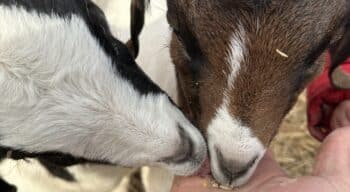Winter Farming and 3 New Goats
March 5, 2024
3 min read

Inherently cyclical, farming is an intentional stroll through the rise and fall of days and seasons. Move too quickly and the infinite to-do list becomes overwhelming and it’s easy to burn out. Conversely, move too slowly, and be forced to watch despondently as the life a farmer is responsible for withers and fades. Born from this balance is the perpetual struggle to maintain personal mental and physical health and simultaneously the health of the complex ecological web farmers are responsible for orchestrating.
Winter days are soft and fleeting, marked by quiet contemplation and reflection, a time to relax and counteract the rush and stress of the busy season. In this season a farmer’s stroll can assume a more leisurely lilt and my dog and I meander through the pastures, contemplating the year behind and the year ahead. Over those hills rolls the wayward bleating of Glen Brook’s latest addition: three Boer goats and my reverie is turned toward the invasive brush creeping over the old fieldstone walls, ever extending beyond the forest edges. The dense thickets of buckthorn and multiflora rose crowd out native species and eliminate habitat for native insects and animals. Oriental bittersweet climbs toward the crowns of oaks, beeches, and maples, choking them out and pulling them down, allowing light to penetrate further, stimulating the growth of more invasives. Yet, the bleating goats give me hope for the coming season.
This past year we had reasonable success with our pigs, rotationally grazing them on the rock walls where they rooted and wallowed, disturbing the root systems of the invasive brush and nibbling at the accessible foliage. This season we are expanding our tactics to keep these invasives at bay, and as I walk along the thick lines of scraggly brush, leafless amidst the winter sun, the deep thickets seem less impenetrable. It will not be long before the days grow warmer and brighter, begetting the budding of the intrusive invaders. With this growth, however, we’ll launch our team of brush goats, who will rotate all season along these walls, browsing and stripping down these plants, all of which are delectable delicacies to our caprine companions. Then, to greater effect, will follow our pigs, who will have increased access to roam and aid in the removal of these plants, no longer hindered by thickness of the thorny hedges.
Each year we can rotate our livestock on these walls, slowly loosening the hold these invasives have on the land. Opening up the edges of the fields, returning them to pasture and hay, which in turn yield better food and forage for our sheep and cows. We can cultivate an environment that better supports native ecology and insect populations, restoring the balance that humans have upset through the introduction of non-native species that are unable to naturalize. As our goats and pigs browse these species, they efficiently and effectively turn plant matter into meat, which at the end of the season is packed into freezers to later grace our tables and fill our stomachs. Through the careful management and integration of livestock into our environment we can regenerate the landscape while simultaneously producing clean and nutritious food for all the visitors and guests at Glen Brook’s meals. This winter, as I restore my depleted stocks of energy, I am renewed by my hope and plans for a more ecologically sound environment, one that better supports the indigenous micro and macro fauna of our quiet New Hampshire corner and maintains the delicate ecological balance that supports such a diverse array of life.











